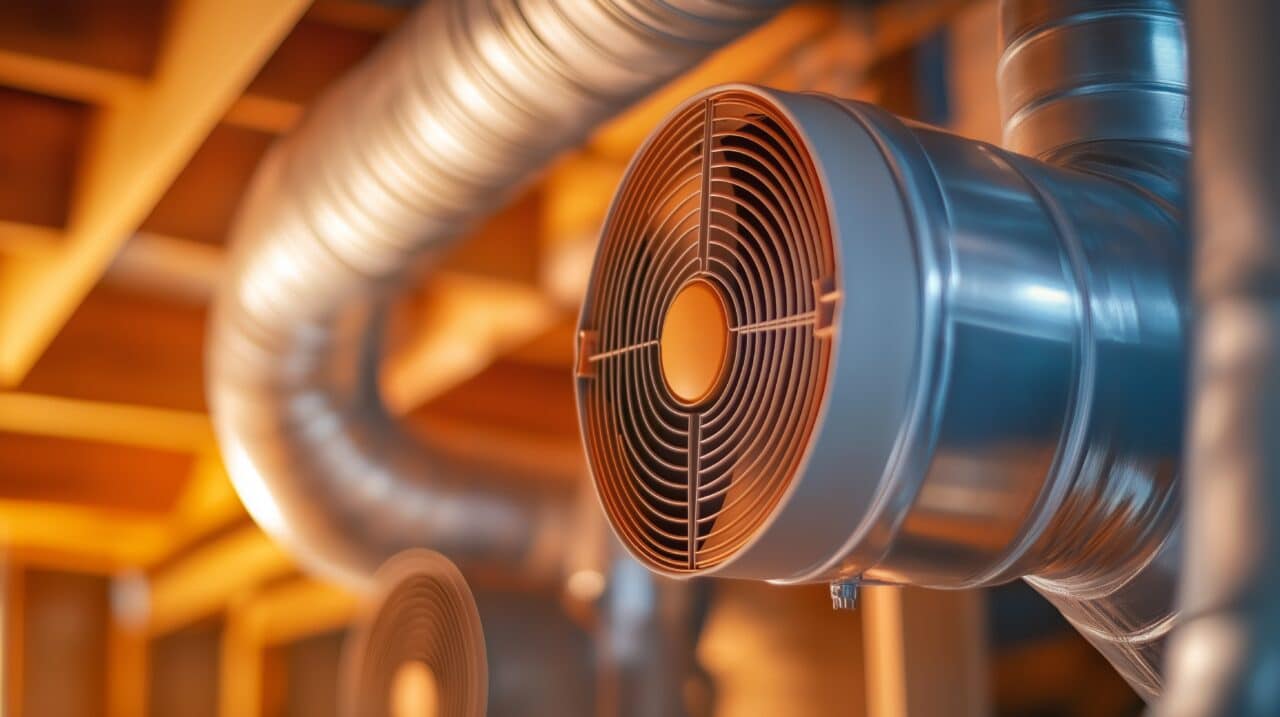When you ventilate a metal building properly, you prevent more than just a few uncomfortable workdays. Without proper airflow, heat and moisture get trapped, leading to bigger issues like rust, mold, and equipment failure.
Combine that with inconsistent temperatures, and you’ll have a costly cycle of repairs and frustrated tenants or employees.
With nearly 80 years of experience, Lee Company has provided trusted solutions to ventilate metal buildings across Tennessee, Alabama, Kentucky, and Georgia. In this blog, we’ll explore why ventilation matters, effective methods to achieve it, and actionable steps to improve airflow.
Why Proper Ventilation is Important
Without proper ventilation, moisture and heat become trapped, creating the perfect conditions for problems like warped metal panels, compromised insulation, and overheating of electrical systems. For facility managers, this means skyrocketing repair costs, lost productivity, and potential equipment failure.
Plus, according to OSHA, poor ventilation is a major contributor to indoor air quality (IAQ) issues, leading to health problems like respiratory irritation, headaches, and fatigue among occupants. These risks are especially significant in facilities like manufacturing plants, storage warehouses, or distribution centers, where prolonged exposure to pollutants or stale air can impact both worker health and operational efficiency.
The National Renewable Energy Laboratory (NREL) also highlights that ventilation significantly impacts heating and cooling loads, which in turn affects overall energy consumption (i.e., operating costs).
Benefits of proper ventilation include:
- Prevents structural damage: Stops condensation from accumulating inside walls and roofing, preventing rust, corrosion, and compromised structural integrity.
- Controls air quality: Reduces airborne contaminants like dust, fumes, and chemical vapors found in industrial settings, improving worker health and reducing discomfort, as noted by OSHA.
- Regulates temperature: Prevents heat buildup, which is critical for maintaining optimal conditions in areas like server rooms or equipment storage.
- Protects stored assets: Safeguards machinery, electronics, or temperature-sensitive materials from humidity or heat damage.
- Improves energy efficiency: Enhances HVAC performance, reducing strain, cutting down utility costs, and mitigating the impact on heating and cooling systems, as mentioned by NREL.
Failing to address ventilation puts your people and bottom line at risk. Proper airflow is an essential investment in your facility’s long-term health and success.
Types of Ventilation for Metal Buildings
There are multiple methods for ventilating a metal building, each suited for different needs based on the building’s size, structure, and purpose. The right choice for your facility will depend on its design and the specific challenges you’re trying to address — whether that’s controlling temperature, reducing moisture, or improving indoor air quality.
Here are the most common ventilation options for metal buildings:
Ridge Vents
Ridge vents are positioned along the peak of a sloped roof, allowing hot, rising air to escape naturally. This is particularly effective for large buildings with high ceilings, like warehouses or manufacturing facilities.
The vents promote natural airflow, reducing heat buildup and improving comfort. In buildings with heavy machinery or high heat loads, ridge vents help prevent overheating and minimize strain on your HVAC system, keeping energy costs in check.
Turbine Vents
Wind-powered turbine vents are an energy-efficient option for ventilating metal buildings. These devices use the wind’s natural force to create suction, pulling warm, stale air out of the building.
They don’t require electricity, which makes them cost-effective for facilities aiming to reduce operating costs.
Ideal for medium-sized buildings or those with variable airflow needs, turbine vents can help prevent heat buildup and moisture accumulation, especially in industrial buildings that produce heat and humidity.
Louvers
Louvers are typically installed in the walls or windows of smaller buildings, allowing fresh air to flow in while stale air escapes. By promoting passive airflow, louvers are ideal for buildings with moderate ventilation needs, such as small offices or storage spaces.
For facilities with sensitive materials or equipment, installing louvers can help maintain a comfortable temperature, preventing overheating or damage due to excessive humidity.
Exhaust Fans
Exhaust fans are actively powered systems that expel air from a building. They are essential for facilities that generate heat, fumes, or moisture, such as manufacturing plants and laboratories. Exhaust fans remove air from the building, creating constant airflow and preventing the stagnation of stale, humid, or contaminated air.
Exhaust fans can be strategically placed in large spaces or areas with heavy equipment to optimize ventilation and maintain a healthy environment.
Soffit Vents
Soffit vents are installed along the eaves of a building’s roof to allow fresh air to enter while hot air escapes through ridge vents. These vents work simultaneously to create a continuous airflow system that regulates the building’s interior temperature and keeps it free from moisture buildup.
Soffit vents are especially useful for larger metal buildings where consistent ventilation protects the structure and any stored materials or equipment.
Selecting the right ventilation system involves evaluating the building’s specific needs, climate conditions, and the nature of the operations. Keep in mind that no one-size-fits-all solution exists. A combination of methods usually delivers the best results.
Steps to Ventilate a Metal Building
Installing an effective ventilation system comes down to understanding your building’s unique needs and applying the right solution. The goal is to create optimal airflow that prevents moisture buildup, maintains a comfortable temperature, and improves air quality. Here’s how to go about it:
1. Assess Ventilation Needs
Start by evaluating the building’s size, purpose, and existing ventilation system. Consider how much heat or moisture is produced in various parts of the building.
For example, fitness centers with pools or saunas face significant humidity challenges that can lead to mold if ventilation is inadequate.
Are there areas where heat or humidity buildup is a recurring issue? Identifying these areas will help you focus on the most critical zones for airflow.
2. Choose the Right Ventilation System
Match the system to your building’s design, taking into account the structure and the climate. For instance, ridge vents work well for large buildings with sloped roofs, while turbine vents are a good option for medium-sized buildings needing efficient airflow.
In manufacturing facilities, exhaust fans may be necessary to remove fumes and maintain air quality near machinery, while agricultural buildings often benefit from louvers for natural airflow to keep livestock comfortable.
Are you dealing with a high-traffic warehouse or a temperature-sensitive storage area? Consider combining systems like ridge vents and louvers to get the best results for both air intake and exhaust.
3. Plan Placement Strategically
Are your vents placed where they can create a continuous flow of air? Vents should be installed where hot air naturally rises. Balancing intake and exhaust vents will maximize airflow efficiency.
For example, vent placement is critical in cold storage units to prevent condensation from compromising temperature control and spoiling stored goods. On the other hand, aircraft hangars require airflow that addresses high ceilings and protects expensive equipment from corrosion caused by trapped moisture.
If your building has high walls, how are you managing moisture? Proper vent placement helps prevent condensation, which can lead to rust, mold, and structural damage.
4. Install Vents Properly
Follow manufacturer guidelines and, if needed, consult professionals for installation. Are you following best practices to seal vents and prevent leaks? Proper sealing around vents is critical to maintain system effectiveness.
Lee Company’s licensed technicians install vents according to code and optimize their performance to fit your building’s needs, helping keep your system running efficiently and safely.
5. Test and Maintain the System
Once installed, test the system to ensure consistent airflow. Is your airflow unobstructed? Regularly inspect the vents for blockages and clean them to prevent debris buildup that can impact performance.
Distribution centers, for example, often experience heavy dust buildup due to high traffic and packaging activities. If not cleaned regularly, this buildup can block vents and reduce efficiency.
In the next section, we’ll go into maintenance best practices that will help extend the life of your ventilation system and maintain long-term savings.
Tips for Maintaining Proper Ventilation
As we’ve discussed, poor ventilation leads to mold, moisture buildup, and uncomfortable temperatures, all of which can be costly to fix and negatively impact your operations. To avoid these issues and keep your metal building functioning optimally, ongoing maintenance is a must.
Here’s how to stay ahead of ventilation problems and protect your investment:
- Clean vents and exhaust systems regularly: Dust, dirt, and even rust can build up in vents over time, reducing airflow. For buildings with high heat or humidity loads, like manufacturing plants or warehouses, regular vent cleaning helps maintain consistent airflow and prevent blockages.
- Inspect exhaust fans and HVAC vents: For large industrial or commercial spaces, exhaust systems tied to your HVAC are crucial in controlling air quality and humidity. Make sure exhaust fans are working correctly and that ducts are free of obstructions. In spaces like kitchens or factories with heavy pollutants, fan performance directly impacts air quality and worker health.
- Check for leaks and seal properly: Leaking vents or ducts can cause the system to operate less efficiently, wasting energy and straining your HVAC system. Regularly inspect seals around ducts, exhausts, and intake vents, especially in areas prone to temperature fluctuations or high moisture levels, like storage rooms or production areas.
- Upgrade the system when necessary: If your business is expanding or your facility’s use has changed, your ventilation system may need an upgrade. A larger inventory, new machinery, or a change in building function (such as converting to a different type of manufacturing space) may require additional airflow capacity. Consider adding more exhaust fans and louvers or improving the HVAC system to match these changes.
- Routine system checks for HVAC integration: Many metal buildings integrate their ventilation with HVAC systems for seamless temperature and air quality control. In larger facilities or those with specialized needs (like data centers or laboratories), your HVAC system may include energy recovery ventilators, heat exchangers, or specialized filters. Check filters monthly, and schedule HVAC maintenance according to the manufacturer’s recommendations for the best long-term performance.
Maximize Your Building’s Value with Lee Company
Properly ventilating a metal building is one of the best investments you can make—especially in the Southeast, where heat and humidity can wreak havoc. In places like Tennessee, Alabama, Kentucky, and Georgia, managing moisture and temperature helps preserve the integrity of your assets and prevents unnecessary expenses.
With 80 years of expertise, Lee Company knows exactly how to tailor ventilation solutions to your building’s unique needs. Whether it’s installation or maintenance, we handle it all — ensuring efficiency, compliance, and long-term savings.
Ready to protect your building and cut future costs? Contact Lee Company today, and let’s optimize your ventilation system for the long haul.
Need better airflow? Contact Lee Company for expert metal building ventilation solutions!
CALL US NOW AT 615.567.1000

